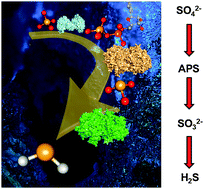Conserving energy with sulfate around 100 °C – structure and mechanism of key metal enzymes in hyperthermophilic Archaeoglobus fulgidus†
Abstract
Sulfate-reducing bacteria and archaea are important players in the biogeochemical sulfur cycle. ATP sulfurylase, adenosine 5′-phosphosulfate reductase and dissimilatory sulfite reductase are the key enzymes in the energy conserving process of SO42− → H2S reduction. This review summarizes recent advances in our understanding of the activation of sulfate to adenosine 5′-phosphosulfate, the following reductive cleavage to SO32− and AMP, and the final six-electron reduction of SO32− to H2S in the hyperthermophilic archaeon Archaeoglobus fulgidus. Structure based mechanisms will be discussed for these three enzymes which host unique metal centers at their catalytic sites.

- This article is part of the themed collection: Microbial Metallomics

 Please wait while we load your content...
Please wait while we load your content...